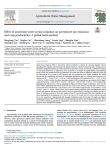Tan M., Cui N., Jiang S., Xing L., Wen S., Liu Q., Li W., Yan S., Wang Y., Jin H., Wang Z. (2025). Effect of practicing water-saving irrigation on greenhouse gas emissions and crop productivity: a global meta-analysis. Agricultural Water Management, 01/03/2025, vol. 308, p. 109300.
https://doi.org/10.1016/j.agwat.2025.109300
https://doi.org/10.1016/j.agwat.2025.109300
| Titre : | Effect of practicing water-saving irrigation on greenhouse gas emissions and crop productivity: a global meta-analysis (2025) |
| Auteurs : | M. Tan ; N. Cui ; S. Jiang ; L. Xing ; S. Wen ; Q. Liu ; W. Li ; S. Yan ; Y. Wang ; H. Jin ; Z. Wang |
| Type de document : | Article |
| Dans : | Agricultural Water Management (vol. 308, March 2025) |
| Article en page(s) : | p. 109300 |
| Langues : | Anglais |
| Langues du résumé : | Anglais |
| Catégories : |
Catégories principales 07 - ENVIRONNEMENT ; 7.5 - Dégradation : Impact, DésertificationThésaurus IAMM METHODE D'IRRIGATION ; CONSERVATION DE L'EAU ; GAZ A EFFET DE SERRE ; EVALUATION DE L'IMPACT ; RENDEMENT DES CULTURES |
| Résumé : | Water-saving irrigation (WSI) is extensively utilized worldwide to address the growing disparity between dwindling water supplies and increasing food demand. Moreover, WSI has attracted extensive attention for its potential to mitigate greenhouse gas (GHG) emissions in agriculture systems. In this study, a global meta-analysis of 1230 observations from 62 publications were conducted to investigate the global patterns and underlying drivers of soil GHG emissions and crop productivity (crop yield and water use efficiency) induced by WSI, and the contributions of key factors to GHG emissions and crop productivity were further quantified. The results showed that WSI significantly alleviated the agricultural greenhouse effect by reducing carbon dioxide (CO2) emission (ln RR = −0.084, 95 %CI: −0.139 to −0.028) and methane (CH4) emissions (ln RR = −0.551, 95 %CI: −0.640 to −0.462). Notably, the global warming potential (GWP) and greenhouse gas intensity (GHGI) significantly decreased by −0.290 (95 %CI: −0.346 to −0.234) and −0.389 (95 %CI: −0.579 to −0.199), respectively, highlighting the effectiveness of WSI in mitigating the impacts of climate change. Furthermore, water use efficiency (WUE) significantly improved by 0.265 (95 %CI: 0.203–0327). However, WSI also led to an increase in nitrous oxide (N2O) emissions by 0.126 (95 %CI: 0.057–0.196) while a slight decrease of crop yield by −0.048 (95 %CI: −0.071 to −0.026). Climate factors such as mean annual precipitation (MAP) and temperature (MAT) directly and indirectly influenced GHG emissions and crop productivity by altering soil properties and the efficacy of fertilization practices. MAP, pH, organic carbon (OC) and bulk density (BD) were identified as key factors responsible for the emissions of CO2 (16.37 %), CH4 (17.35 %) and N2O (20.19 %) as well as crop yield (16.21 %), respectively. Implementing WSI alongside fertilization rates of less than 100 kg/ha can balance mitigating greenhouse effect (GWP and GHGI) and maintaining crop yields. These findings emphasize the critical role of WSI in enhancing agricultural sustainability and reducing GHG emissions, thus providing valuable insights for future management strategies. |
| Cote : | En ligne |
| URL / DOI : | https://doi.org/10.1016/j.agwat.2025.109300 |







